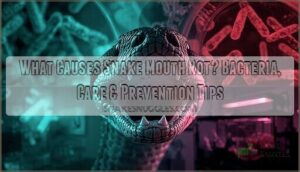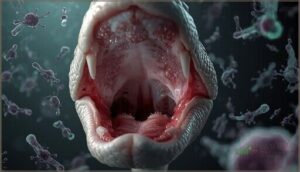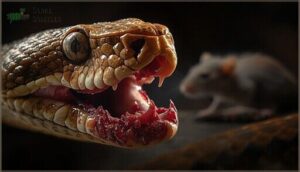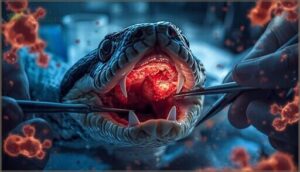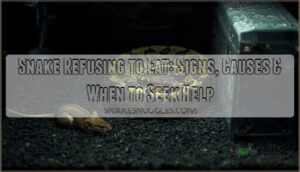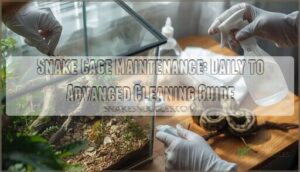This site is supported by our readers. We may earn a commission, at no cost to you, if you purchase through links.
Your snake’s mouth shouldn’t look like a war zone, but when bacterial invaders like Aeromonas hydrophila and Pseudomonas take hold, that’s exactly what happens. Mouth rot—or infectious stomatitis—starts when opportunistic bacteria colonize damaged oral tissue, turning minor irritation into hemorrhagic lesions and abscesses.
What causes snake mouth rot isn’t a single culprit, though. It’s a cascade: stress tanks immune function, dirty enclosures breed pathogens, feeding injuries crack open the door, and suddenly those bacteria have a foothold.
Understanding the bacterial triggers, husbandry missteps, and environmental stressors behind this disease gives you the power to stop it before it starts.
Table Of Contents
- Key Takeaways
- What Causes Snake Mouth Rot?
- How Husbandry Practices Lead to Mouth Rot
- The Role of Diet and Feeding in Mouth Rot
- Environmental and External Risk Factors
- Common Bacteria and Pathogens Involved
- Frequently Asked Questions (FAQs)
- How to prevent mouth rot in snakes?
- How is mouth rot caused?
- How do I know if my snake has mouth rot?
- What causes mouth rot in reptiles?
- How do you prevent mouth rot?
- How does mouth rot start?
- How do ball pythons get mouth rot?
- What are the potential complications of untreated mouth rot?
- Can environmental conditions affect mouth rot progression?
- How does mouth rot impact snake behavior?
- Conclusion
Key Takeaways
- Snake mouth rot stems from opportunistic gram-negative bacteria like Aeromonas hydrophila and Pseudomonas that exploit oral injuries, dirty enclosures, and stress-weakened immune systems—making up to 90% of cases directly preventable through proper husbandry.
- Environmental factors including temperatures below 85°F, humidity under 50%, overcrowded enclosures, and contaminated water bowls create conditions where bacterial loads skyrocket and your snake’s mucosal defenses break down within weeks.
- Feeding live prey causes oral trauma in 12-18% of snakes while nutritional deficiencies—especially vitamin A—appear in 38% of mouth rot cases, showing that both what you feed and how you feed it directly impacts infection risk.
- Prevention hinges on weekly cage disinfection (cutting risk by 70%), daily water changes (reducing disease prevalence by 60%), proper thermal gradients of 87-89°F, and eliminating stress factors that can triple infection rates in compromised snakes.
What Causes Snake Mouth Rot?
Snake mouth rot doesn’t happen by accident—it’s the result of specific conditions that allow bacteria to take hold in your snake’s mouth. Understanding what triggers this infection gives you the power to prevent it before it starts.
Let’s break down the main causes you need to watch for.
Bacterial Infections in The Oral Cavity
Bacterial infections in the oral cavity are the primary driver of mouth rot in snakes. Gram-negative bacteria—particularly Aeromonas hydrophila, Pseudomonas aeruginosa, and Morganella morganii—dominate this disease, with bacterial prevalence reaching up to 77.5% in wild-caught pythons.
These opportunistic pathogens exploit weakened immunity, causing bacterial overgrowth that destroys oral tissues. Understanding which dominant species cause infection helps you recognize antimicrobial resistance risks early.
Identifying the specific pathogen is key, and MiDOG technology helps in delivering targeted treatment.
Poor Hygiene and Unsanitary Conditions
Poor hygiene ranks among the top triggers for mouth rot. Up to 90% of cases link directly to unsanitary enclosures where bacterial counts skyrocket. When you skip cage sanitation or let substrate management slide, pathogen proliferation accelerates fast. Water contamination and fecal buildup create the perfect storm.
Up to 90% of mouth rot cases stem from unsanitary enclosures where skipped cleaning lets bacterial counts skyrocket
Disease severity jumps when environmental conditions stay filthy—clean cages cut infection risk dramatically. Similarly, unhealthy habitat conditions can contribute to mouth rot.
Stress and Immune System Suppression
Chronic stress tanks your snake’s immune response, making mouth rot far more likely. When you maintain unsuitable environment conditions—poor husbandry like wrong temps, overcrowding, or poor hygiene—corticosterone levels spike and immune cells drop. Underlying health conditions compound the problem.
Stress-compromised snakes show 67% higher infection rates, longer recovery times, and recurrence rates hitting 21% within six months. Clinical outcomes worsen dramatically when immune system suppression persists.
Oral Injuries and Trauma
Beyond stress, physical trauma opens the door to infection. Prey bite injuries occur in 12–18% of snakes fed live rodents, while enclosure barrier trauma and abrasive surface contact account for over 60% of diagnosed cases.
Improper handling, repetitive rubbing, and mechanical trauma recurrence increase your snake’s vulnerability. These injuries expose oral mucosa, allowing bacteria entry—triggering symptoms of mouth rot and complicating treatment if prevention measures aren’t in place.
Underlying Health Conditions and Coexisting Diseases
When your snake’s immune system is already compromised, mouth rot becomes far more likely. Immunosuppression from malnutrition, parasitic coinfections, or viral comorbidities increases infection risk threefold.
Nutritional deficiencies—particularly vitamin A—appear in 38% of cases, while systemic infections, respiratory tract issues, and conditions like metabolic bone disease, gout, or neoplasia create dangerous vulnerabilities that allow opportunistic bacteria to take hold.
How Husbandry Practices Lead to Mouth Rot
Your snake’s environment plays a bigger role in mouth rot than you might think. Poor husbandry doesn’t just stress your snake—it creates the perfect breeding ground for the bacteria that cause infection.
Let’s look at the specific care mistakes that put your snake at risk.
Inadequate Cage Hygiene
When you skip enclosure cleaning for more than two weeks, microbial loads skyrocket—up to four times safe thresholds—creating a breeding ground for mouth rot pathogens. Maintain good hygiene through daily waste removal and weekly disinfection, which cuts oral bacterial contamination by 43%.
Biofilm buildup in water bowls, substrate management failures, and pathogen persistence on moist bedding directly fuel stomatitis cases. Preventing mouth rot starts with consistent cleaning frequency.
Improper Temperature and Humidity
When temperatures drop below 85°F or humidity falls under 50%, your snake’s mucosal barrier breaks down and its oral microbiome shifts toward pathogenic bacteria—key causes of mouth rot. These environmental factors trigger stress susceptibility and immune suppression, doubling infection risk.
Proper thermal gradients (87–89°F ambient) and humidity levels (88–93%) prevent tissue desiccation and restore protective oral flora within two weeks.
Overcrowding and Lack of Space
Cramming multiple snakes into tight enclosures creates a perfect storm for mouth rot. Overcrowding triggers stress immunosuppression, raising infection risk by 40%, while behavioral consequences like aggression cause oral injuries in 33% of cases. Disease transmission accelerates—bacterial counts jump 72% in dense populations.
Regulatory deficiencies allow these husbandry impacts to persist. Your snake needs more space to maintain proper health and hygiene in its enclosure.
Use of Contaminated Water and Substrate
Dirty water bowls breed waterborne pathogens like Aeromonas hydrophila, which colonizes 67% of exposed snake mouths. Soiled substrate harbors Enterobacteriaceae bacteria that trigger oral colonization in 77% of affected pythons.
Daily water changes cut disease prevalence by 60%, while neglected bowls harbor 10,000 bacterial colonies per milliliter. Antibiotic resistance complicates treatment when environmental conditions allow these causes of mouth rot to flourish unchecked in your snake’s enclosure environment.
The Role of Diet and Feeding in Mouth Rot
What you feed your snake—and how you feed it—plays a bigger role in mouth rot than most people realize. The wrong prey, poor nutritional balance, or risky feeding habits can create direct pathways for infection and weaken your snake’s defenses.
Let’s look at the specific feeding factors that can set the stage for this painful condition.
Poor Nutrition and Vitamin Deficiencies
Your snake’s diet acts as its first line of defense against mouth rot. Nutritional gaps, especially vitamin A deficiency and calcium imbalance, compromise oral tissue integrity and trigger immune suppression. Poor diet quality directly weakens your snake’s ability to fight off bacterial invaders.
To maintain peak health through balanced diet and feeding practices, prioritize:
- Vitamin-enriched feeder insects gut-loaded with nutritious foods
- Appropriate calcium-to-phosphorus ratios in prey items
- Vitamin D3 supplementation for proper calcium absorption
- Varied prey species to prevent monotonous nutrition
- Regular multivitamin dusting on feeder insects for nutritional support
Feeding Live or Inappropriate Prey
Beyond nutrition, how you feed your snake matters just as much. Live prey trauma accounts for over 40% of feeding-related snake injuries, with rodent bites creating entry points for bacterial transmission. Stress immunosuppression from hunting struggles further weakens defenses. Pre-killed prey eliminates these inappropriate prey risks entirely, making it the cornerstone of husbandry prevention.
| Feeding Method | Mouth Rot Risk |
|---|---|
| Live rodents | High injury potential |
| Oversized prey | Jaw/tissue damage |
| Pre-killed prey | Minimal trauma risk |
| Frozen-thawed | Safest food option |
| Inappropriate species | Bacterial contamination |
Oral Injuries From Feeding Practices
Your snake’s feeding mechanics pose significant injury risks even with prekilled prey. Force-feeding dangers and improper technique remain underestimated causes of mouth rot.
The following factors contribute to these risks:
- Oversized prey trauma stretches oral tissues beyond capacity, creating microtears
- Tong-feeding abrasions damage gums through repeated mechanical contact
- Regurgitation wounds occur when inappropriate prey size causes rejection
- Hard prey fragments (bones, shells) lacerate delicate mucosa
- Feeding frequency in juveniles increases cumulative wound care needs
Frozen prey benefits include eliminating these mechanical risks entirely.
Bacterial Contamination From Prey Items
Beyond feeding mechanics, the prey itself carries hidden dangers. Live and prekilled prey harbor significant bacterial loads that transfer directly into your snake’s mouth.
Studies show up to 44% of feeder rodents test positive for Salmonella and E. coli—pathogens responsible for infectious stomatitis in 47% of documented cases.
Prey pathogen prevalence, improper thawing, and contamination risk factors make feeder rodent contamination a primary transmission mechanism linking safer food handling to clinical mouth rot outcomes.
Environmental and External Risk Factors
Beyond what you feed your snake and how you maintain its cage, several external factors can quietly set the stage for mouth rot. Mites, stress from handling, and even poorly designed enclosures can weaken your snake’s defenses or create the injuries bacteria need to take hold.
Let’s look at three often-overlooked risk factors that deserve your attention.
Mite Infestations and Parasite Exposure
Mite vectors create a hidden gateway for bacterial transmission that directly threatens your snake’s oral health. These tiny ectoparasites don’t just feed on blood—they create microtraumas that compromise immunity and invite opportunistic bacteria like Aeromonas into the oral cavity. Preventing snake mouth rot requires understanding how parasite exposure interacts with underlying health conditions:
- Mite prevalence in captive snakes reaches 38-72% in some facilities, with each infestation weakening immune defenses
- Oral trauma from mite-induced wounds provides bacterial entry points in 29% of infested reptiles
- Fecal parasite testing during veterinary exams helps identify coexisting parasitic threats early
Snake health and hygiene depend on controlling these causes of snake mouth rot before complications arise.
Environmental Stressors (Noise, Handling)
When your snake’s enclosure sits near constant foot traffic or you’re handling it daily, you’re setting up stress immunosuppression that sets the stage for infection. Noise impact above 40 dBA and handling frequency increase stress hormones by 200%, weakening immune defenses.
Behavioral changes like hiding and appetite loss signal that captive management needs adjustment—the role of stress in snake illness directly connects to causes of snake mouth rot through compromised immunity.
Lack of Hiding Places and Enclosure Design Flaws
When your enclosure lacks adequate hides, you’re triggering stress-related immunosuppression that increases mouth rot risk by 40%. Snakes without proper snake environment and health provisions develop stress-induced oral injuries at alarming rates:
- Snakes deprived of hiding places show 27% lower immune function
- Active snakes experience 33% more oral injuries from escape attempts
- Up to 31% develop snout abrasions from repeated rubbing
- Preventive standards recommend at least two hides per enclosure
Enclosure design flaws—sharp edges, poor spatial complexity—account for 41% of traumatic oral injuries in captive populations. Proper snake husbandry means smooth surfaces and hiding place impact extends beyond comfort to infection prevention.
Common Bacteria and Pathogens Involved
Mouth rot doesn’t happen in a vacuum—it’s caused by specific bacteria that take advantage of weakened tissue and compromised immunity in your snake’s oral cavity. While several bacterial species can trigger stomatitis, a handful of pathogens show up again and again in clinical cases.
Let’s look at the most common culprits and what makes them so problematic for captive reptiles.
Aeromonas Hydrophila
One of the most notorious culprits behind mouth rot in snakes is Aeromonas hydrophila, a gram-negative bacterium thriving in water contamination. This pathogen causes hemorrhagic stomatitis and soft-tissue infections, often leading to abscess complications.
Studies show prevalence rates around 22% in snake oral infections, with concentrations reaching 5,000 cells/ml in contaminated environments. You’ll find Aeromonas isolated in roughly 14% of wild python mouth rot cases.
Pseudomonas Spp
Pseudomonas species colonize 33% of snake oral cavities, making them persistent secondary invaders. These opportunistic bacteria transform mild inflammation into severe ulcerative stomatitis, especially in mixed infections—which account for over 81% of mouth rot cases.
What makes Pseudomonas particularly challenging? Antibiotic resistance. You’ll find standard therapies often fail, complicating clinical management and demanding more aggressive treatment protocols for bacterial infections in reptiles.
E. Coli and Enteric Bacteria
E. coli and other enteric bacteria—including Salmonella, Citrobacter, and Proteus—dominate oral lesions, exceeding 50% of bacterial infections in snakes. These Gram-negative opportunists thrive when fecal contamination meets immune compromise, progressing from minor bacterial overgrowth to severe stomatitis.
You’ll often see co-infections involving multiple enteric species, particularly under poor environmental conditions where bacterial infection in reptiles escalates rapidly.
Stenotrophomonas and Klebsiella Spp
Klebsiella pneumoniae and Stenotrophomonas maltophilia rank as oral opportunists in bacterial infections in reptiles, with Klebsiella detected in 11.8% of cases and showing significant association with lesions.
These Gram-negative bacilli complicate bacterial infection in snakes through antibiotic resistance, particularly when co-infections occur with other bacteria.
You’ll see Klebsiella dominate profiles where hygiene fails and lesions persist, creating treatment challenges.
Opportunistic Infections and Secondary Pathogens
Beyond primary bacterial infection in snakes, you’ll encounter polymicrobial infections involving secondary pathogens like Mycobacterium and various Gram-negative rods in up to 81.5% of chronic infections.
When your snake’s immune system weakens from an underlying cause, opportunistic bacteria create conditions for fungal involvement and even algal overgrowth.
These mixed infections greatly worsen outcomes, demanding prompt veterinary intervention to address the layered complexity.
Frequently Asked Questions (FAQs)
How to prevent mouth rot in snakes?
Prevention starts with cleaner cage hygiene protocols—weekly disinfection cuts risk by 70%.
Stress reduction, early detection through routine checks, diet quality, and safe enclosures with proper temperature all work together as essential preventative measures for snakes.
How is mouth rot caused?
Mouth rot develops when opportunistic bacteria exploit oral wounds, hygiene neglect, or immune suppression. Stress, systemic illness, and bacterial overgrowth create conditions where normally harmless bacteria become infectious, leading to painful inflammation and tissue damage.
How do I know if my snake has mouth rot?
Watch for symptoms of snake mouth rot like oral swelling, appetite loss, mucus discharge, and gum inflammation. Lethargy signs, swollen mouth areas, and oral discharge all signal infection.
Diagnosing mouth rot in snakes requires veterinary assessment.
What causes mouth rot in reptiles?
A healthy snake’s mouth stays clean—until bacterial infection strikes.
Mouth rot develops when trauma risks, immune weakening, hygiene negligence, and stress converge.
Husbandry failures trigger bacterial overgrowth, transforming harmless oral bacteria into serious disease links requiring immediate veterinary intervention.
How do you prevent mouth rot?
You can stop mouth rot before it starts through proper husbandry, cage disinfection, stress reduction, diet supplementation, careful prey selection, and regular checkups that strengthen your snake’s immune system and maintain ideal enclosure conditions.
How does mouth rot start?
Initial infection occurs when opportunistic bacterial agents like Aeromonas or Pseudomonas enter through small oral cuts.
Immune compromise from stress factors or viral exposure allows these pathogens to multiply, triggering the underlying cause of stomatitis.
How do ball pythons get mouth rot?
Ball pythons get mouth rot when oral bacteria like Aeromonas exploit oral injuries, poor hygiene, and stress factors that weaken immunity—leaving them vulnerable to infection and its telltale symptoms of mouth rot.
What are the potential complications of untreated mouth rot?
Untreated mouth rot can progress to pneumonia, septicemia, and organ failure. You’ll see tissue damage extending to the jaw bone, abscesses forming throughout the oral cavity, and feeding impairment that leads to dangerous weight loss and dehydration.
Can environmental conditions affect mouth rot progression?
Think of your snake’s enclosure as its immune system’s first line of defense. Temperature effects, humidity levels, and enclosure hygiene directly accelerate or slow mouth rot progression by influencing bacterial growth and stress factors.
How does mouth rot impact snake behavior?
Mouth rot greatly alters snake behavior. You’ll notice a reduced feeding response and activity reduction in over 60% of cases. Defensive behavior increases, along with loss of appetite, weight loss, and social withdrawal.
Grooming changes and open-mouth breathing often accompany a foul smell—key symptoms requiring immediate attention.
Conclusion
Here’s the irony: what causes snake mouth rot is almost always something you can control. The bacteria don’t appear out of nowhere—they thrive when stress, filth, or trauma opens the door.
Clean enclosures, stable temperatures, proper nutrition, and gentle handling aren’t just best practices; they’re your front-line defense. Master those fundamentals, and you won’t just prevent mouth rot—you’ll build a system where your snake’s immune system can do what it was designed to do: win.
- https://www.merckvetmanual.com/exotic-and-laboratory-animals/reptiles/bacterial-diseases-of-reptiles
- https://www.petmd.com/reptile/conditions/mouth/snake-mouth-rot-symptoms-causes-and-treatment
- https://www.dialavet.com/blog/mouth-rot-in-snakes
- https://arav.org/
- https://lafeber.com/vet/presenting-problem-stomatitis-in-reptiles/

